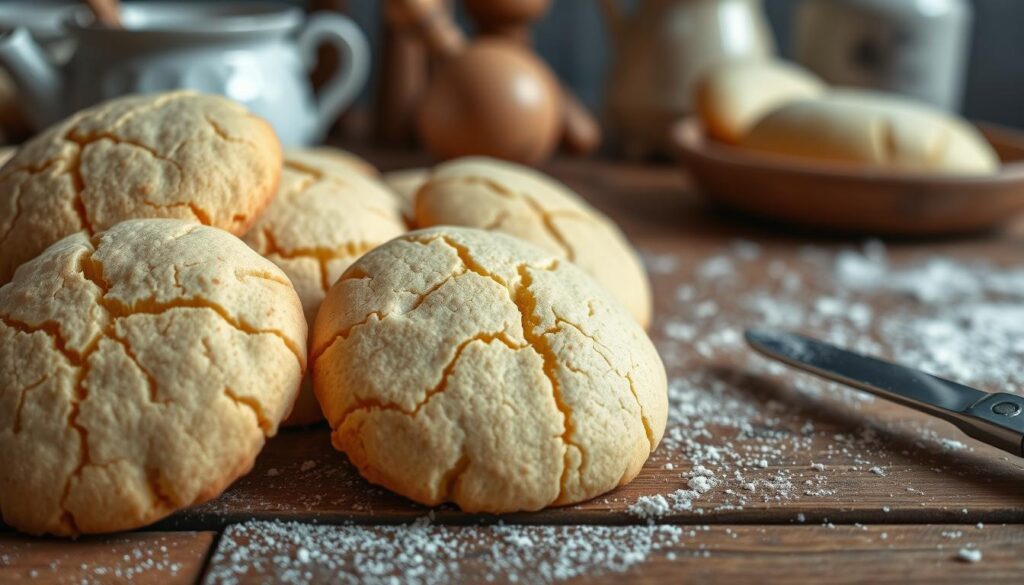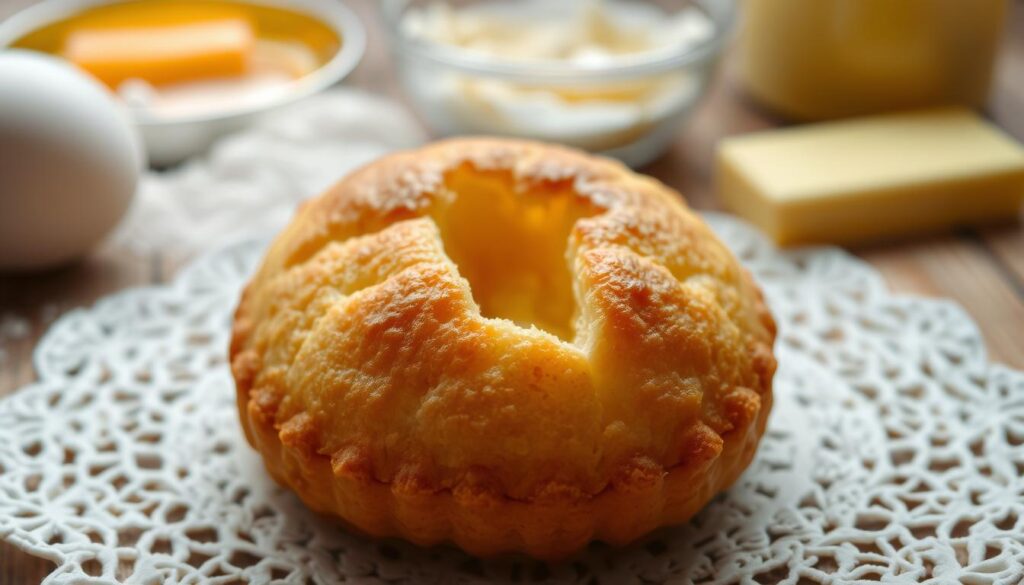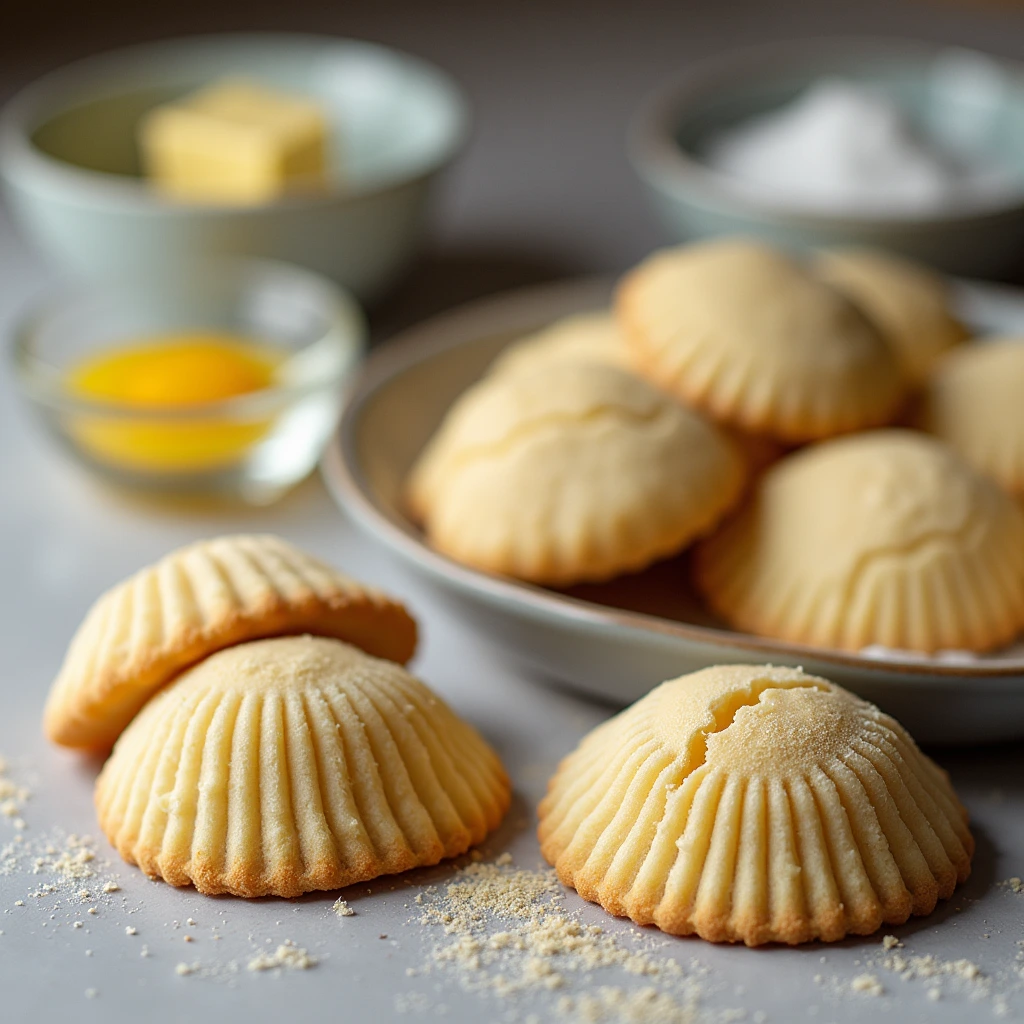Madeleines are a French butter cake known for their shell shape and moist texture. But, when they turn dry, it’s a disappointment for bakers. To fix this, we need to understand why it happens and how to make them moist again.
In this article, we’ll explore the reasons behind dry madeleines. We’ll also share tips to make them moist and fluffy, just like they should be.

Key Takeaways
- Madeleines should be baked for 10 to 12 minutes at 375°F for optimal moisture.
- Chilling the batter for at least five hours can significantly improve texture.
- Adjacent ingredients like warm melted butter help maintain moisture retention.
- Using the right size non-stick pans is crucial; two pans are recommended for most recipes.
- Leftover madeleines should be stored in an airtight container to keep them fresh.
Understanding Madeleines: A Brief Introduction
Madeleines are loved worldwide, known as tasty madeleine cookies. They come from France and are famous for their special texture and taste. The batter, similar to French butter cakes, uses whipped eggs and important ingredients like butter, flour, and sugar.
A classic recipe shows their light and airy quality. This is thanks to vanilla or citrus zest added to the mix.
Making madeleine cookies is both a skill and a science. Whipping egg whites with sugar takes about 8–9 minutes on medium-high speed. This step is key for their light structure.
Chilling the dough for at least 4 hours helps. It makes the flour absorb moisture and breaks down gluten. This improves the texture and taste.

Baking at the right temperature is crucial. Starting at 425°F for three minutes and then lowering to 400°F helps them rise well. When done right, these treats have a unique flavor and texture that’s hard to resist.
Common Characteristics of Moist Madeleines
The characteristics of moist madeleines are key for bakers aiming for the perfect treat. A well-baked madeleine has a fluffy inside and crisp edges. The high “hump” comes from good aeration in the batter, which is vital for texture.
Each bite should be tender, rich in buttery flavor, and have a delicate crumb. This crumb should melt in your mouth.
Chilling the batter for at least two hours, or overnight, helps a lot. This makes the “bump” on top more noticeable. The cold batter and hot oven create this contrast. Using a special madeleine pan keeps the treats in their shell shape, a key feature of this classic dessert.
Ingredient ratios are also crucial. Adding almond meal keeps madeleines moist for days. Brown butter adds a nutty flavor, making the taste richer. Recipes can also include lemon or pumpkin spice for different flavors. This lets bakers try new things while keeping the core baking tips for madeleines in mind.
| Characteristic | Importance |
|---|---|
| Fluffy Interior | Creates a light texture for a pleasant mouthfeel. |
| Crisp Edges | Adds a contrasting texture enhancing the overall experience. |
| High “Hump” | Result of proper aeration and chilling, adds visual appeal. |
| Rich Butter Flavor | Gives depth to the taste, making it more enjoyable. |
| Delicate Crumb | Ensures a melt-in-your-mouth sensation. |
Understanding these traits helps bakers see the balance needed for perfect madeleines. By following good baking tips for madeleines, bakers can make treats that delight everyone who tries them.

Why Are My Madeleines Dry?
Several factors can make madeleines dry. Knowing these helps improve this French pastry. Finding common problems helps fix dryness for better results.
Overbaking Effects on Texture
Overbaking is a big reason for dry madeleines. Too much heat makes them lose moisture, becoming tough. To avoid this, bake at 425°F (220°C) for 3 minutes first. Then, lower the heat to 320°F (160°C) for 2-3 more minutes. This careful temperature control prevents overbaking.
Incorrect Ingredient Proportions
Getting the right mix of ingredients is key. Too much flour or not enough eggs can make them dry. A good recipe balances 120 grams of flour with 140 grams of butter and eggs. Adjusting these amounts helps keep them moist.
Storage Errors and Their Impact
Storing madeleines wrong can also dry them out. They should be in an airtight container at room temperature for 2-3 days. Not storing them right lets air in, drying them out. Proper storage is key for keeping them fresh.
The Role of Ingredients in Moisture Retention
The ingredients you choose greatly affect the texture and moisture of madeleines. Knowing which ingredients keep them moist is key to making them fluffy and tender. Each ingredient plays a part in the batter, so it’s important to understand their roles.
Importance of Eggs in the Batter
Eggs are vital in the batter, with about 73% water, 13% proteins, and 12% fat. This water content is crucial for making the madeleines moist. The proteins in eggs help the madeleines hold their shape during baking.
Egg yolks add emulsifiers like lecithin, making the batter smooth and improving texture. Whole eggs add water, richness, and flavor, thanks to their fat content.
How Butter and Oil Influence Moisture
Butter and oil in madeleine recipes add flavor and help retain moisture. Butter makes the taste richer, while oil, when melted, makes the crumb tender. Fats weaken the structure slightly, helping to achieve the right moisture level.
The Impact of Sugar Types on Texture
Sugar greatly affects the sweetness and moisture of madeleines. Its hygroscopic nature helps it hold onto water, adding to the batter’s moisture. White sugar sweetens, while honey adds a unique taste and keeps madeleines moist longer.
The type of sugar used can change the texture of each batch of madeleines.
Baking Techniques That Affect Madeleines
Getting the right baking techniques for madeleines is key to perfect texture and flavor. Following the best practices can really improve your baking. Here are some important techniques to keep in mind:
Chilling the Batter: Why It’s Crucial
Chilling the batter helps the flour absorb better and adds air. This step is crucial for the madeleine hump, a key feature of these cookies. Chill the batter for at least 3 hours, but overnight is best. This step makes the final texture better.
Temperature Control in Baking
Keeping the oven temperature right is important for madeleines. Heat it to 350°F to avoid problems. Too high a temperature can burn the edges and leave the center raw. Bake for 10 to 12 minutes, until the edges are golden. This careful temperature control ensures moist and tasty results.
The Right Pan for Perfect Madeleines
A madeleine pan designed for the job makes a big difference. It ensures even baking and the signature shape. The right pan helps with texture and looks, key for great madeleines. Switching to a proper pan can boost your baking skills.
Fixing Dry Madeleine Cookies: Step-by-Step Guide
Fixing dry madeleine cookies is easier than you think. With a few simple steps, you can make these treats moist and delicious. Follow this guide to achieve moist madeleines every time.
Revising Your Recipe for Success
First, check your ingredient amounts. Add ingredients like milk or honey to make the batter wetter. Here’s a basic recipe to start with:
| Ingredient | Amount |
|---|---|
| Unsalted Butter | 113g plus 28g for greasing |
| Caster Sugar | 70g |
| Demerara Sugar | 15g |
| Plain Flour | 90g |
| Eggs | 3 large |
| Lemon Zest | 1 tsp |
| Vanilla Extract | 1 tsp |
Adjusting Baking Times and Temperatures
Try baking for less time and at a lower temperature. Baking at 350°F (177°C) helps them bake evenly. This can make a big difference in their texture.
Incorporating Moisture-Retaining Ingredients
Adding yogurt to the batter can make them even moister. It also makes them softer. These changes will help your madeleines stay moist and tender.
Best Practices for Storing Madeleines
Storing madeleines right is key to keeping their taste and texture. Using these tips helps your treats stay moist and tasty longer. You’ll want to know both quick and long-term ways to store them.
Short-Term Storage Solutions
For quick enjoyment, store madeleines in a sealed container at room temperature. This keeps them fresh for 2-3 days. An airtight container keeps air out, keeping them soft and flavorful. Don’t refrigerate them, as cold air can dry them out.
Long-Term Preservation Tips
To keep madeleines longer, freezing is a good choice. Wrap them tightly in plastic or foil and put them in airtight containers. This way, they can last up to 2 months in the freezer. Thaw them in the fridge overnight, then let them warm up before eating for the best taste.
Enhancing Your Madeleines Recipe with Flavor
Making your madeleines more flavorful can also make them more moist. Adding citrus zest brightens the taste and adds a tangy touch. This mix of flavors can make your madeleines even more special.
Adding Citrus Zest for Extra Moisture
Adding zest from oranges or lemons to your batter is a simple way to enhance flavor. It not only makes the taste richer but also keeps the cookies moist. The citrus oils add a nice aroma and balance to the flavor.
Infusing with Vanilla and Other Extracts
Using top-quality vanilla extract or other flavors like almond or coconut can change your madeleines’ taste. These extracts add sweetness and improve the texture. Vanilla also helps keep the cookies moist, making them tender and tasty.
| Flavoring Method | Flavor Profile | Moisture Impact | Serving Suggestions |
|---|---|---|---|
| Citrus Zest | Bright and Tangy | Enhances moisture retention | Pairs well with tea or coffee |
| Vanilla Extract | Sweet and Creamy | Improves texture and tenderness | Ideal for afternoon snacks |
| Almond Extract | Nuts and Sweet | Supports moist texture | Great for dessert platters |
| Coconut Extract | Tropical and Sweet | Helps retain moisture | Perfect for summer gatherings |
Seeking Help: When to Ask for Professional Advice
Knowing when to ask for help can really improve your baking. If you’re struggling with a madeleine recipe or want to get better, expert advice can help. There are many resources like forums, communities, and books to guide you.
Utilizing Baking Forums and Communities
Online baking forums are full of useful info and support. By joining these groups, you meet other bakers who share their knowledge and tips. Talking with others can give you new ideas to make your madeleines better.
Consulting Books by Renowned Chefs
Books by famous chefs are packed with helpful tips and advice. They offer detailed guidance on recipes, including madeleines. These books are great for learning new techniques and avoiding common mistakes.
Experimenting with Variations: What Works?
Exploring madeleine variations can be a fun adventure. You can try both old and new recipes to add your own twist. This way, you can make the flavors and textures just right for you.
Traditional vs. Modern Recipes
Classic recipes stick to simple ingredients like flour and butter. For example, Orange Almond Madeleines mix flour, almond flour, orange zest, and osmanthus syrup. On the other hand, modern recipes might use matcha or different sweeteners. This mix of old and new can create exciting tastes and textures.
Incorporating Different Flours and Fats
Changing the flour and fat in madeleines can change the whole experience. Using whole wheat flour can make them taste richer. Coconut oil adds a special flavor. By trying different fats and flours, you can make madeleines that are just how you like them.
Conclusion
Madeleines are a delightful treat that requires a balance of ingredients and techniques. To master them, focus on batter preparation, baking times, and storage. Chilling the batter is key to getting that signature rise and “hump.”
A good recipe, like David Lebovitz’s A Sweet Life in Paris, highlights the need for quality ingredients. Use unsalted butter, fresh lemon zest, and the right amount of baking powder. A good madeleine pan is essential for creating tender, buttery, and lemony cookies.
Enjoy your madeleines on the day they’re baked for the best flavor. The secret to mastering madeleines is experimenting and a love for baking. Every detail, from brushing molds with melted butter to adjusting baking times, makes a difference. These practices will bring joy to both you and your loved ones.
FAQ
What are madeleines?
Madeleines are small, shell-shaped cakes from France. They are made with a sponge-like batter called génoise. This batter is mostly eggs, which makes them light and airy.
How can I make my madeleine cookies moist?
To make moist madeleines, use the right amount of ingredients. Don’t overbake them. Adding milk or yogurt can also help.
What causes dryness in madeleines?
Overbaking and wrong ingredient ratios can make madeleines dry. Also, not storing them properly can cause moisture loss.
How should I store madeleines to maintain freshness?
Keep madeleines in an airtight container at room temperature for a short time. For longer storage, wrap them well and freeze in an airtight container.
Is chilling the batter really necessary?
Yes, chilling the batter is key. It helps the flour absorb moisture better and increases airiness. This is what makes a madeleine’s signature “hump.”
Can I use different types of flour in madeleine recipes?
You can try different flours like whole wheat or almond flour. But, you might need to adjust the recipe to get the right texture and flavor.
What are some flavor enhancements for madeleines?
Adding citrus zest, vanilla extract, or other extracts can make madeleines taste better. These can also add moisture or fat, changing the texture.
Where can I find reliable baking advice?
Look for advice on online forums and in books by famous bakers. They share tips and solutions that can improve your madeleine baking.
Why does my madeleine batter need to be aerated?
Beating eggs into the batter is crucial. It makes the batter light and fluffy, which is what makes madeleines so special.

